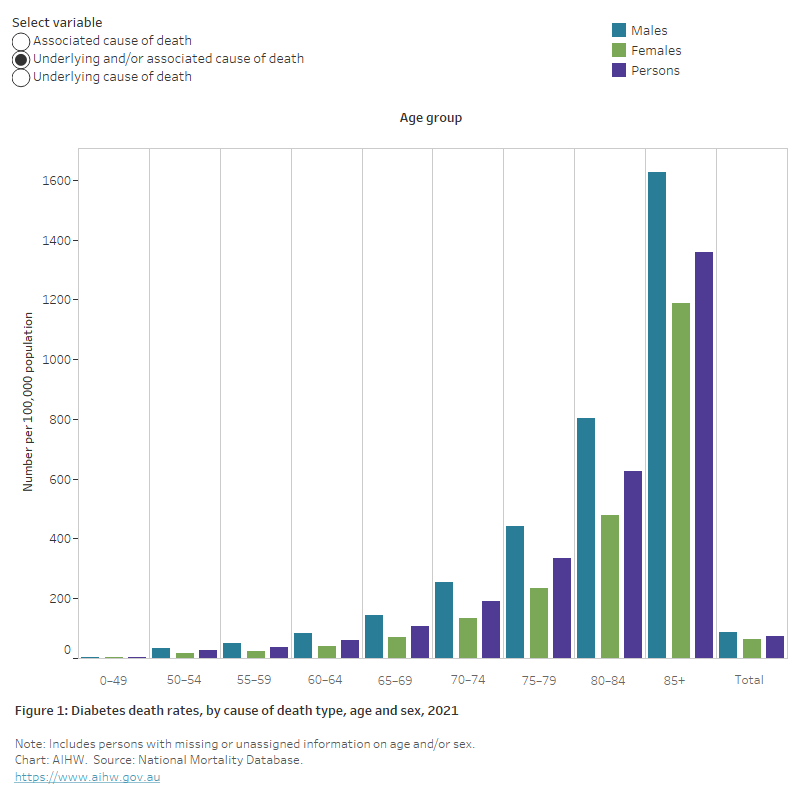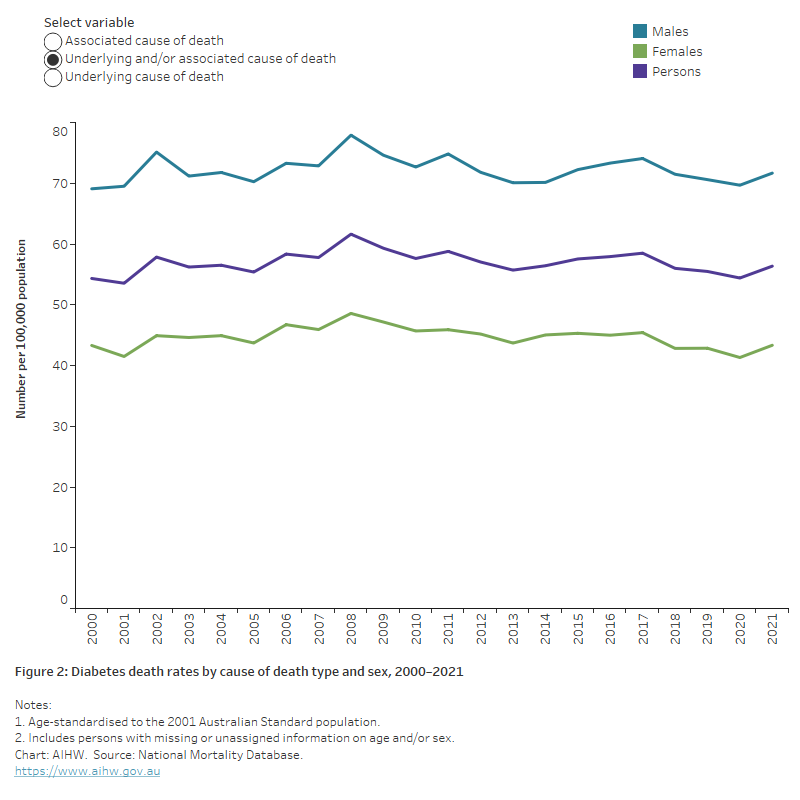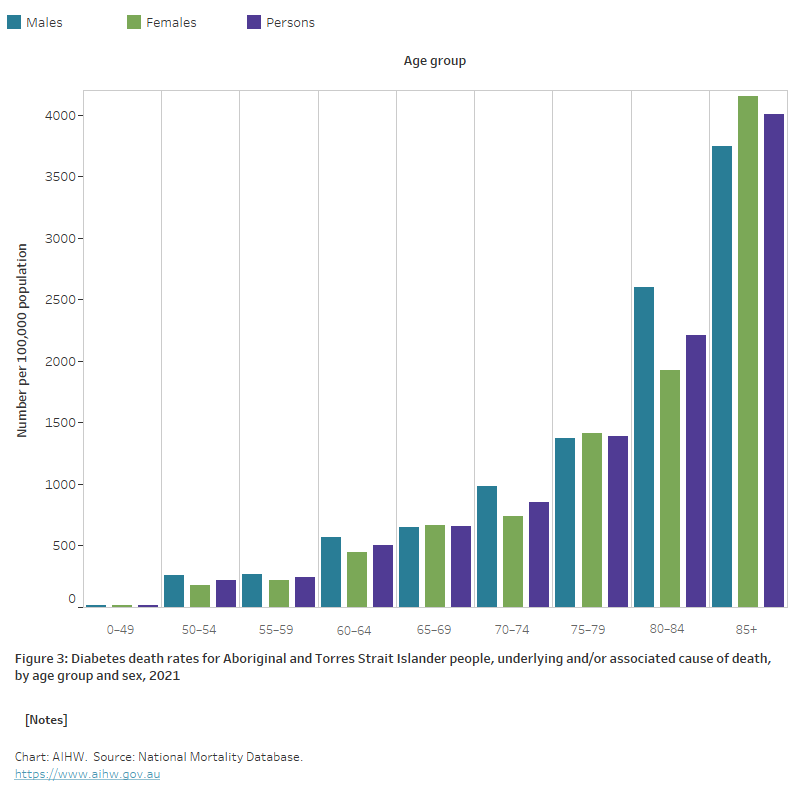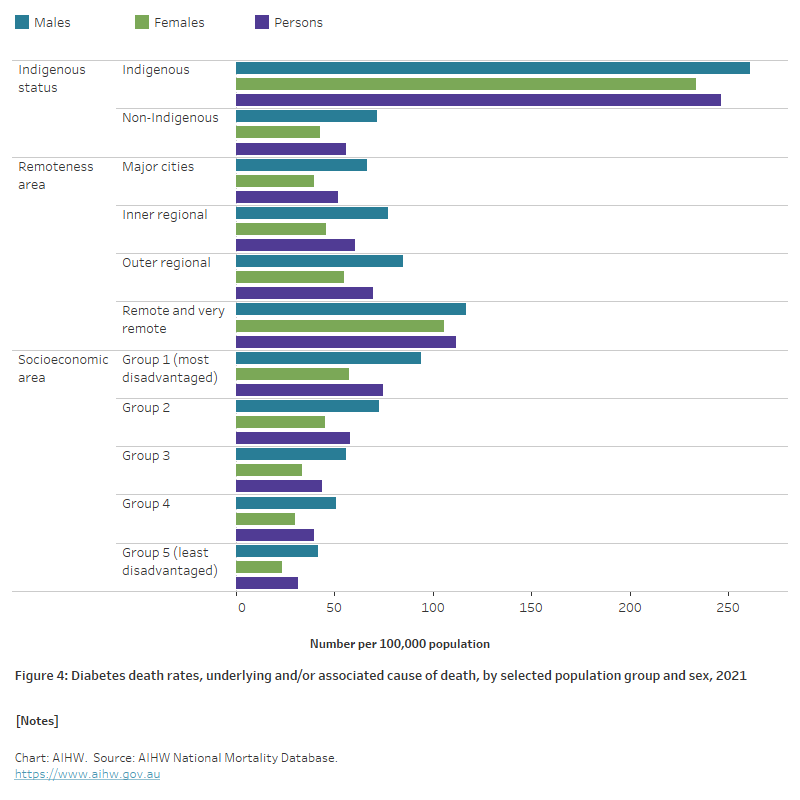Diabetes deaths
Page highlights:
How many deaths are associated with diabetes in Australia?
- Diabetes contributed to around 19,300 deaths in 2021 (11.2% of all deaths) and was among the 10 leading causes of death in Australia.
- Males were 1.7 times as likely to die from diabetes as females.
- Age-standardised mortality rates for diabetes (underlying and/or associated cause) increased by 3.7% between 2020 and 2021.
- There were 833 deaths associated with diabetes among Aboriginal and Torres Strait Islander people in 2021.
How many deaths are associated with diabetes in Australia?
Diabetes was among the 10 leading causes of death of Australians in 2021 (ABS 2021), contributing to around 19,300 deaths (11.2% of all deaths) according to the National Mortality Database. Diabetes was the underlying cause of death in around 5,400 deaths (28% of diabetes deaths). It was an associated cause of death in a further 13,900 deaths (72% of diabetes deaths).
Where diabetes was listed as the underlying and/or associated cause of death:
- 4.2% were due to type 1 diabetes
- 58% were due to type 2 diabetes
- 38% were due to other or unspecified diabetes.
Note: Examining only the underlying cause of death can underestimate the impact of diabetes on mortality (Harding et al. 2014). This is because it is often not diabetes itself that leads directly to death, but one of its complications that will be listed as the underlying cause on the death certificate. See Diseases commonly associated with diabetes deaths for further information. Further, deaths from diabetes are known to be under-reported in national mortality statistics, as diabetes is often omitted from death certificates as a cause of death (McEwen et al. 2011; Whittall et al. 1990).
Variation by age and sex
In 2021, mortality rates for diabetes (as the underlying and/or associated cause):
- increased with increasing age, with rates 2.2 times as high in those aged 85 and over compared with those aged 80–84 and 4.1 times as high as those aged 75–79 (Figure 1)
- were 1.7 times as high in males compared with females, after controlling for age
- were highest in those aged 85 and over for both males and females at 1,600 and 1,200 per 100,000 population, respectively.
Figure 1: Diabetes death rates, by cause of death type, age and sex, 2021
The chart shows the diabetes death rates by cause of death type, age and sex in 2020. Diabetes death rates (as any cause of death) were highest among males in each age group from 50 and over and increased with increasing age, peaking among those aged 85 and over.

Trends over time
Age-standardised mortality rates for diabetes (as the underlying and/or associated cause) have remained relatively stable since 2000, with a slight increase of 3.7% between 2020 and 2021.
Between 2000 and 2021:
- total deaths related to diabetes increased from 5,400 to 10,900 for males and 4,700 to 8,400 for females.
- age-standardised diabetes mortality rates (underlying and/or associated cause) were consistently 1.6–1.7 times as high among males as females (Figure 2).
Note: The Australian Bureau of Statistics (ABS) Provisional Mortality Statistics focus on monitoring patterns of mortality and highlight any changes potentially associated with the COVID-19 pandemic. According to ABS Provisional Mortality Statistics, in 2022, the number of doctor-certified deaths due to diabetes (as the underlying cause) was 17.3% above the baseline average (comprising the years 2017–2019 and 2021). See Diabetes deaths during COVID-19 for more information.
Figure 2: Diabetes death rates by cause of death type and sex, 2000–2021
The chart shows the trend in diabetes death rates, by cause of death type between 2000 and 2020. Diabetes death rates (as any cause of death) peaked overall in 2008 and have gradually declined since then with rates in 2020 slightly below those seen in 2008. Though death rates are around 1.7 times higher among males than females, the trends are similar among the sexes.

Variation between population groups
Aboriginal and Torres Strait Islander people
There were 833 deaths from diabetes (as the underlying and/or associated cause) among Aboriginal and Torres Strait Islander people in 2021, a rate of 108 per 100,000 population. Almost half (46%) of Indigenous Australian deaths from diabetes occurred in those aged under 65. Indigenous males and females aged 85 and over had the highest mortality rate across all age groups (3,700 and 4,200 cases per 100,000 population, respectively) (Figure 3).
After adjusting for differences in the age structure of the populations, diabetes death rates were 4.4 times as high among Indigenous Australians as non-Indigenous Australians (Figure 4).
Note: Data for diabetes deaths among Aboriginal and Torres Strait Islander people are reported for 5 jurisdictions, including New South Wales, Northern Territory, Queensland, South Australia and Western Australia. Data quality issues and the small number of Indigenous deaths makes the data less reliable in the other jurisdictions.
Figure 3: Diabetes death rates for Aboriginal and Torres Strait Islander people, underlying and/or associated cause of death, by age group and sex, 2021
The chart shows the diabetes deaths rates as an underlying and/or associated cause of death for Aboriginal and Torres Strait Islander people by age group and sex in 2020. Death rates increased with increasing age peaking among males at age 80–84 and females at age 85 and over (2,444 and 2,201 per 100,000 population, respectively). Rates were higher among males than females from age 65–69 to 80–84, were similar among the sexes for those aged below 60 and higher among females from age 85 and over.

Remoteness area
In 2021, after adjusting for differences in the age profile of the populations, diabetes death rates (as the underlying and/or associated cause) increased with the level of remoteness with rates being 2.2 times as high in Remote and very remote areas as in Major cities. This disparity was more pronounced among females than males (2.7 and 1.8 times as high, respectively) (Figure 4).
Socioeconomic area
In 2021, diabetes death rates (as the underlying and/or associated cause) increased with increasing levels of socioeconomic disadvantage. After adjusting for differences in the age structure of the populations, rates were 2.4 times as high among those living in the lowest socioeconomic areas as those living in the highest socioeconomic areas. This disparity was slightly higher among females than males (2.5 and 2.2 times as high, respectively) (Figure 4).
Figure 4: Diabetes death rates, underlying and/or associated cause of death, by selected population group and sex, 2021
The chart shows the age-standardised diabetes death rates as the underlying and/or associated cause by selected population group and sex in 2020. Overall, diabetes death rates increased with increasing levels of socioeconomic disadvantage being 2.4 times as higher among those living in the most disadvantaged areas as those living in the least disadvantaged areas. Diabetes death rates also increase with the level of remoteness being 1.8 times as high among those living in Remote and very remote areas as Major cities. Indigenous Australians were 5 times as likely to die from diabetes as non-Indigenous Australians.

Australian Bureau of Statistics (2021), Causes of Death, Australia, ABS Website, accessed 31 May 2023.
Harding JL, Shaw JE, Peeters A, Guiver T, Davidson S and Magliano DJ (2014) ‘Mortality trends among people with type 1 and type 2 diabetes in Australia: 1997–2010’, Diabetes Care, 37:2579–586, doi:10.2337/dc14-0096.
McEwen L, Karter A, Curb J, Marrero D, Crosson J and Herman W (2011) ‘Temporal trends in recording of diabetes on death certificates: results from Translating Research into Action for Diabetes (TRIAD)’, Diabetes Care, 34(7):1529–33, doi:10.2337/dc10-2312.
Whittall DE, Glatthaar C, Knuiman MW and Welborn TA (1990) ‘Deaths from diabetes are under-reported in national mortality statistics’, Medical Journal of Australia, 152(11):598–600, doi:10.5694/j.1326-5377.1990.tb125391


